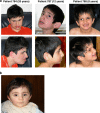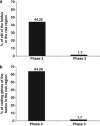Genome-wide linkage analysis is a powerful prenatal diagnostic tool in families with unknown genetic defects
- PMID: 23032112
- PMCID: PMC3598323
- DOI: 10.1038/ejhg.2012.198
Genome-wide linkage analysis is a powerful prenatal diagnostic tool in families with unknown genetic defects
Abstract
Genome-wide linkage analysis is an established tool to map inherited diseases. To our knowledge it has not been used in prenatal diagnostics of any genetic disorder. We present a family with a severe recessive mental retardation syndrome, where the mother wished pregnancy termination to avoid delivering another affected child. By genome-wide scanning using the Affymetrix (Santa Clara, CA, USA) 10k chip we were able to establish the disease haplotype. Without knowing the exact genetic defect, we excluded the condition in the fetus. The woman finally gave birth to a healthy baby. We suggest that genome-wide linkage analysis--based on either SNP mapping or full-genome sequencing--is a very useful tool in prenatal diagnostics of diseases.
Figures



Similar articles
-
Linkage and exome analysis implicate multiple genes in non-syndromic intellectual disability in a large Swedish family.BMC Med Genomics. 2019 Nov 6;12(1):156. doi: 10.1186/s12920-019-0606-4. BMC Med Genomics. 2019. PMID: 31694657 Free PMC article.
-
Use of linkage data obtained in single families: prenatal diagnosis of a new X-linked mental retardation syndrome.Am J Med Genet. 1992 Apr 15-May 1;43(1-2):415-9. doi: 10.1002/ajmg.1320430163. Am J Med Genet. 1992. PMID: 1605220
-
Complex aetiology of an apparently Mendelian form of mental retardation.BMC Med Genet. 2008 Feb 6;9:6. doi: 10.1186/1471-2350-9-6. BMC Med Genet. 2008. PMID: 18254962 Free PMC article.
-
Genetic linkage analysis in the age of whole-genome sequencing.Nat Rev Genet. 2015 May;16(5):275-84. doi: 10.1038/nrg3908. Epub 2015 Mar 31. Nat Rev Genet. 2015. PMID: 25824869 Free PMC article. Review.
-
SNP array analysis in constitutional and cancer genome diagnostics--copy number variants, genotyping and quality control.Cytogenet Genome Res. 2011;135(3-4):212-21. doi: 10.1159/000331273. Epub 2011 Sep 16. Cytogenet Genome Res. 2011. PMID: 21934286 Review.
Cited by
-
Molecular Diagnostics of Ciliopathies and Insights Into Novel Developments in Diagnosing Rare Diseases.Br J Biomed Sci. 2022 Jan 10;79:10221. doi: 10.3389/bjbs.2021.10221. eCollection 2022. Br J Biomed Sci. 2022. PMID: 35996505 Free PMC article. Review.
-
A multiple regression method for genomewide association studies using only linkage information.J Genet. 2018 Jun;97(2):477-482. J Genet. 2018. PMID: 29932068
References
-
- Alfonso-Sanchez MA, Pena JA. Effects of consanguinity on pre-reproductive mortality: does demographic transition matter. Am J Hum Biol. 2005;17:773–786. - PubMed
-
- Hussain R. The impact of consanguinity and inbreeding on perinatal mortality in Karachi, Pakistan. Paediatr Perinat Epidemiol. 1998;12:370–382. - PubMed
-
- Jorde LB. Consanguinity and prereproductive mortality in the Utah Mormon population. Hum Hered. 2001;52:61–65. - PubMed
-
- Modell B, Darr A. Science and society: genetic counselling and customary consanguineous marriage. Nat Rev Genet. 2002;3:225–229. - PubMed
Publication types
MeSH terms
LinkOut - more resources
Full Text Sources
Other Literature Sources
Medical

